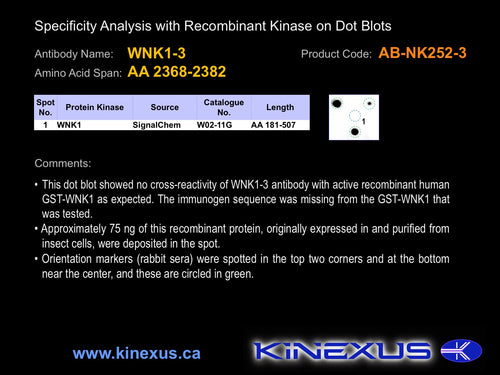Product Name:
WNK1-3
Product Number:
ab-nk252-3
Target Full Name: Serine/threonine-protein kinase WNK1
Target Alias: HSAN2; HSN2; KDP; KIAA0344; MGC163339; MGC163341; p65; PRKWNK1; Protein kinase with no lysine 1; Protein kinase, lysine-deficient 1; PSK; PHA2C; CCDS8506.1; ENSG00000060237
Product Type Specific: Protein kinase pan-specific antibody
Antibody Code: NK252-3
Antibody Target Type: Pan-specific
Protein UniProt: Q9H4A3
Protein SigNET: Q9H4A3
Antibody Type: Polyclonal
Antibody Host Species: Rabbit
Antibody Immunogen Source: Human WNK1 sequence peptide Cat. No.: PE-01AZA99
Antibody Immunogen Sequence: CQKSISNPPGSNLRTT
Antibody Immunogen Description: Corresponds to amino acid residues Q2368 to T2382; C-terminus
Production Method: Corresponds to amino acid residues Q2368 to T2382; C-terminus
Antibody Modification: Protein kinase pan-specific antibody
Antibody Concentration: 0.75 mg/ml
Storage Buffer: Phosphate buffered saline pH 7.4, 0.05% Thimerasol
Storage Conditions: For long term storage, keep frozen at -40°C or lower. Stock solution can be kept at +4°C for more than 3 months. Avoid repeated freeze-thaw cycles.
Product Use: Western blotting | Antibody microarray
Antibody Dilution Recommended: 2 µg/ml for immunoblotting
Antibody Species Reactivity: Human
Antibody Positive Control: The observed molecular mass of the processed target protein on SDS-PAGE gels is reported to be around 190, 250-400 kDa.
Antibody Specificity: Medium
Related Product 1: WNK1-3 blocking peptide
Related Product 2: WNK1-1 pan-specific antibody (Cat. No.: AB-NK252-1)
Related Product 3: WNK1-2 pan-specific antibody (Cat. No.: AB-NK252-2)
Related Product 4: WNK1-pS382 phosphosite-specific antibody (Cat. No.: AB-PK855)
Related Product 5: WNK1-pT2245 phosphosite-specific antibody (Cat. No.: AB-PK857)
Related Product 6: WNK1-pT60 phosphosite-specific antibody (Cat. No.: AB-PK856)
Scientific Background: WNK1 (PRKWNK1) is a protein-serine/threonine kinase of the Other group and WNK family. It is involved in electrolyte homeostasis, cell survival, cell signalling, and cell proliferation. It is activated by hypertonicity. The activation requires autophosphorylation of S382. Phosphorylation of S378 also promotes increased phosphotransferase activity. WNK1 can activate sodium-coupled chloride cotransporters, and inhibit potassium-coupled chloride cotransporters. Proteins activated by WNK1 include SCNN1A, SCNN1B, SCNN1D and SGK1 while an inhibited protein is WNK4 (via phosphorylation of WNK4 or an associated complex of a WNK1 autoinhibitory domain bound to WNK4). WNK4 inhibition could modulate, via phosphorylation, a thiazide-sensitive NaCl cotransporter transporter (specifically SLC12A3). WNK1 has also been proposed to modulate NEDD4L phosphorylation, and have an effect on actin cytoskeleton rearrangement. Insertional mutagenesis studies in mice support a role for this protein kinase in mouse cancer oncogenesis.


